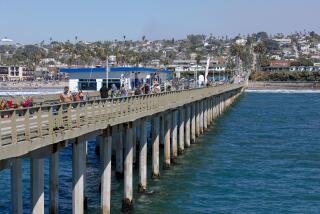From Rubble to Reef : Group Vows to Help Turn Doomed Pier’s Concrete Into Fish Habitat
- Share via
HUNTINGTON BEACH — A sportfishing group on Thursday offered to raise $67,600 needed to create an artificial fishing reef using concrete rubble from the soon-to-be demolished Huntington Beach Municipal Pier.
The vow by the Gill Net Watch Committee, a group of 40 Southern California fishing and diving industry representatives, clears the way for a city proposal to create new habitat for fish and other marine life.
No city funds will be used for the project, but Huntington Beach will collect the donations and help promote a fund-raising campaign, Mayor Thomas J. Mays said at a news conference at the beach Thursday.
The committee already has raised $25,000 for the reef project, said Jim Paulk, a consultant for the group, which advocates marine conservation and the abolition of gill-net fishing.
Plans calls for the Bolsa Chica Artificial Reef to be located about 5 1/2 miles west of the pier. Clusters of concrete would be arranged in an area 1 mile long and a quarter-mile wide.
The rock piles, each ranging in width from about 50 feet to 100 feet, would be in about 65 feet of water, deep enough so the surf would not be affected, said Jim Palin, a city deputy administrator.
On Monday, the City Council will consider the reef proposal along with hiring a firm to level and reconstruct the pier. Officials said the company chosen to finish the pier also would cut the concrete pilings and beams into smaller pieces to be hauled in barges to the reef site.
Paulk said he is confident the group can collect the money for the project. “If the City Council gives us time, I think we can raise it,” he said. “We’ve already gotten about half of what we need in just the first week.”
The city has raised about $5.5 million of an estimated $9.5 million needed for pier reconstruction. The cost includes razing and rebuilding the structure and several restaurants, snack stands and bait shops.
Demolition of the pier--closed after being ravaged by winter storms in 1988--is scheduled to begin after Labor Day. Work is expected to be completed by mid-1992.
Officials said the city requested an additional fund-raising effort for the reef project because its cost was not included in the pier-reconstruction price tag.
While the plan would help state Department of Fish and Game efforts to build more artificial reefs to replace deteriorating kelp beds, city officials also have heralded the proposal as a way to recycle tons of concrete that otherwise would be hauled away to a dump.
“This project is positive all the way around. We have an opportunity here to enhance the underwater environment rather than haul all this rubble off to some landfill,” Mays said.
The pier’s concrete is an ideal material for an artificial reef, said Kimberly K. McKee, a state Department of Fish and Game marine biologist. Marine plants grow quickly and abundantly on the concrete surfaces, “and within minutes, all kinds of fish show up,” she said.
Most of the pier’s 175 pilings and concrete support beams would be used in the new reef, Palin said. But wooden remains and smaller concrete rubble are not suitable for the project, and will either be re-used in road-construction projects or dumped in a landfill, he said.
Over the past 32 years, the Department of Fish and Game has created about 30 artificial reefs off the coastline from Santa Cruz to the Mexican border. Pollution and storms have depleted many of the state’s kelp beds, a vital component of marine life, creating a need for artificial habitats, McKee said.
There are now seven artificial reefs off the Orange County coast, including six surrounding the new proposed site off Huntington Beach. The other reef is north of the Newport Harbor jetty.
More to Read
Sign up for Essential California
The most important California stories and recommendations in your inbox every morning.
You may occasionally receive promotional content from the Los Angeles Times.









